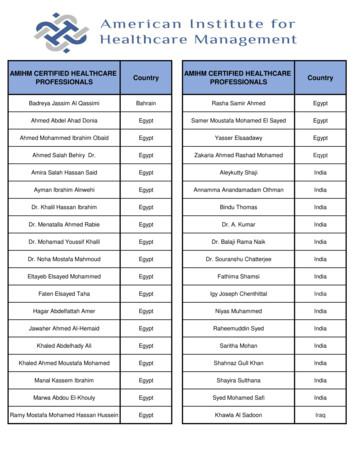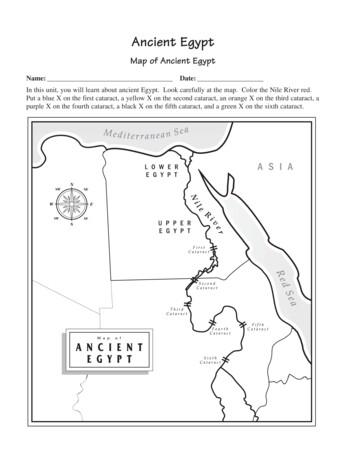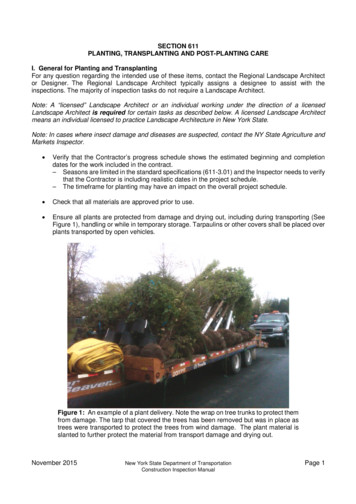Ancient Egypt Worksheets - Macmillan Education Everywhere
Photocopiable ResourcesMacmillan Children’s ReadersWorksheets and Teacher’s NotesContentsAncient Egypt Worksheet 1Ancient Egypt Worksheet 2Ancient Egypt Worksheet 3Ancient Egypt Worksheet 4Answer KeyTeacher’s NotesAlex Raynham
Name:Class:Ancient Egypt Worksheet 11 Complete the crossword.Across12p a pyrus31 The ancient Egyptiansused to make paperand boats.44 The Nile is the river in Africa.7 The job of an was toto make a body8into a mummy.5678 The Egyptians built to their gods.Down2 The pharaohs lived in beautiful 3 knew how to read and write.5 The ancient Egyptians used plants to make cloth.6 There was a in the Nile Valley every summer.2 Correct the sentences.1 Most of Egypt is green, but the Nile Valley is a desert.Most of Egypt is a desert, but the Nile Valley is green.2 The ancient Egyptians used mud bricks to make boats.3 Rameses the Great was pharaoh for 20 years.4 A sphinx has got a lion’s head and a pharaoh’s body.5 The bed inside Tutankhamun’s tomb was made of stone.6 Howard Carter made horror films about mummies.7 The ancient Egyptians wrote a story about a pharaoh, a girl and a hat.PHOTOCOPI Macmillan Publishers Limited 2014ABLE
Name:Class:Ancient Egypt Worksheet 21 Complete the words.1 ph a r aoh2 brk3 st7b6 slusv4 stn5 hrgphs2 Read and match. Write the letters in the boxes.1 At the temple in Luxor, Rameses the Great f2 The biggest pyramid in Egypt is 3 The stones for the pyramids came on 4 To make a mummy, embalmers used 5 Many tombs in the Valley of the Kings 6 An archeologist called Howard Carter 7 The ancient Egyptians loved 8 A Frenchman took 23 years to 9 Egypt became part of the Roman 10 The ancient Egyptians used fbuilt two huge obelisks.b translate the hieroglyphs.g Empire after 30 BC.c were full of amazing treasures.h found the tomb of Tutankhamun.d scissors, keys and calendars.ithe Great Pyramid of Khufu, at Giza.e music, dancing and nice clothes.jsalts to dry the body.TOOPH Macmillan Publishers Limited 2014COPIABLEa boats along the river Nile.
Name:Class:Ancient Egypt Worksheet 31 Put the sentences in order.a It rains, and the people of Egypt are very happy.b Nefertari reads the curse in the Book of Thoth.c Setne tries to shoot an arrow, but he misses.1d Setne rides back across the river.e The children find a tomb.fSetne has a dream, then he rides a horse very well.2 Make questions to ask Prince Setne.a go / did / Why / Nile / the / and / you / across / Nefertari ?Why did you and Nefertari go across the Nile?b find / Where / the / Thoth / Book / of / did / you ?c competition / you / riding / Did / win / a ?d were / your / Why / worried / parents ?e you / take / Where / did / book / the ?3 Match the questions from Activity 2 with Setne’s answers.1 I took it back to the tomb.e2 No, I won an archery competition.3 We found the book inside a tomb.4 We went across the Nile to practise archery.5 They were worried because the people were hungry.PHOTOCOPI Macmillan Publishers Limited 2014ABLE
Name:Class:Ancient Egypt Worksheet 41 Complete the ta Narmer Khufu1 King Narmerat Memphis.built the first capital2 Queenbuilt a huge3 At Luxor,two huge.the Great built.4 The biggestpharaoh5 TheEgyptiancityat Giza was for the.Stone helped people understand.2 Play a game.Write a sentence about a person in the book.Read your sentence to your friend.This pharaoh built a capital city.Can your friend guess who it is?Yes, it is!Is it Narmer?3 Write a postcard.TOOPH Macmillan Publishers Limited 2014COPIABLEImagine you are visiting one of the places in the book.Write a postcard to your friend about your visit.Tell your friend where you are and what you have seen. Do you like the place?You can find out more information on the Internet.
Answer KeyWorksheet 1p a 2p y r u s3sa4cl o n g e s tra5icf67fbe m b a l m e r8t e m p l e sasoxod11 Complete the crossword.21234567Correct the sentences.Most of Egypt is a desert, but the Nile Valley is green.The ancient Egyptians used mud bricks to make houses.Rameses the Great was pharaoh for more than 60 years.A sphinx has got a lion’s body and a pharaoh’s head.The bed inside Tutankhamun’s tomb was made of gold.Howard Carter was an archeologist. / found Tutankhamun’s tomb.The ancient Egyptians wrote a story about a pharaoh, a girl and a pair of shoes.Worksheet 21 Complete the words.1 pharaoh, 2 bricks, 3 statue, 4 stone, 5 hieroglyphs, 6 slave, 7 obelisk2 Read and match. Write the letters in the boxes.1f, 2i, 3a, 4j, 5c, 6h, 7e, 8b, 9g, 10dWorksheet 31 Put the sentences in order.a6, b3, c1, d5, e2, f42abcdeMake questions to ask Prince Setne.Why did you and Nefertari go across the Nile?Where did you find the Book of Thoth?Did you win a riding competition?Why were your parents worried?Where did you take the book?3 Match the questions from Activity 2 with Setne’s answers.1e, 2c, 3b, 4a, 5dWorksheet 4112345Complete the sentences.King Narmer built the first capital city at Memphis.Queen Hatshepsut built a huge temple.At Luxor, Rameses the Great built two huge obelisks.The biggest pyramid at Giza was for the pharaoh Khufu.The Rosetta Stone helped people understand Egyptian writing.2 Play a game.Children’s own answers.3 Write a postcard.Children’s own answers. Macmillan Publishers Limited 2014
Teacher’s Notes(1 of 2)Ancient EgyptSubject linksHistory, Geography, Art, Science, Design and TechnologyThe factual sectionContents pageIn L1 ask the children to look at the pictures on the cover and the contents page, and ask them whatthey know about ancient Egypt. What subjects do they think will be in the Reader? Discuss thepurpose of the contents page and ask them to say on which page they can find out about differenttopics.As you read with the children, stop and ask them questions. Encourage them to make comparisonswith historical people, places and events in their countries or cities. Ask: What do we use to makebuildings/boats/clothes now? Who was the most famous king or queen of your country? Whathistorical buildings/statues are there in this city? What places do tourists visit in this city/country?Using the photographsAsk the children who or what they can see in each photo. What are the people doing?Choose a photo and teach or revise phrases for describing photos, e.g. at the top/bottom; on theleft/right; In my photo, there is/are ; My photo shows/has got a Ask the children to work in pairs and to describe photos to each other. Can they find the photo inthe book from the description?Using the Amazing FactsAsk the children about the information in the fact boxes, e.g. Was a sphinx a real animal? How manypyramids did archeologists find in 2011?Project workAsk groups of children to find out more about a topic in the book, e.g. the Nile, important pharaohsor Egyptian artefacts, and to present their topic to the class using a poster or by giving apresentation.Ask the children to make posters about the pharaohs. Ask them to choose one of the pharaohs andto complete a fact file. For example:Name:Born:Died:Was pharaoh for years.Is famous because Ask the children to write a paragraph about their chosen pharaoh, using their notes, and to find apicture on the Internet or to draw a picture.Explore links with other curriculum areas. Cross-curricular activities include: designing an ancient Egyptian costume building a model of a pyramid or temple making a poster about the river Nile or ancient Egyptian artefacts using mud and plants to learn how to make mud bricks (which need to be baked outside in thesun) learning how to use plants and recycled paper to make a homemade paper scroll. Macmillan Publishers Limited 2014
Teacher’s Notes(2 of 2)The story sectionTitle pageLook at the picture and ask questions such as Where are the children? Who do you think they are?What is he/she wearing? Ask the children to predict (in L1) what they think is going to happen in thestory.Remind the children that the ancient Egyptians liked to write stories (see page 12). Explain that TheBook of Thoth is based on a real ancient Egyptian story: in ancient Egyptian legends the Book ofThoth was a special book which contained all the knowledge in the world; anyone who read thebook would know everything and be able to do anything. Also explain that Egyptian books werewritten on papyrus, so they were actually scrolls.Ask the children to think about what the characters are feeling and thinking at different points inthe story. Encourage them to think of questions to ask the characters, e.g. (to Setne) Why do youwant to keep the book? Why is your sister angry with you? Ask them to say what the characters’answers would be.Ask the children as they read to speculate and discuss the story. For example: Why do you think Setne took the book from the tomb? Why did the river Nile become dry? How do you think Setne felt when he returned the Book of Thoth? Why does the pharaoh call Setne ‘a great pharaoh’ at the end of the story?Tell the children that ancient Egyptian stories always had morals. Brainstorm in L1 what the moralof this story might be. (The main moral is that people are not great only because of their personalachievements. People become great when they think of others rather than themselves.)Put the children in groups and ask them to act out or mime part of the story.Ask the children to draw a picture of one of the characters, based on the story illustrations. Displaythe pictures on the classroom walls.Using the activities and worksheetsThese focus on vocabulary and reading comprehension tasks. The children should refer back to theReader as they work on them.Using the Bilingual DictionaryDraw a pyramid on a big piece of paper or on the board. As the children learn new words, writethem on cards and stick them on the pyramid. Point out the dictionary at the back of the book andencourage the children to look up unknown words. When the children write the words in theirlanguage, make sure that they find the word in the Reader first. This will ensure that they translatethe word according to how it is used in the Reader. Macmillan Publishers Limited 2014
5 The ancient Egyptians used plants to make cloth. 6 There was a in the Nile Valley every summer. 2 Correct the sentences. 1 Most of Egypt is green, but the Nile Valley is a desert. Most of Egypt is a desert, but the Nile Valley is green. 2 The ancient Egyptians used mud bricks to make boats.
Ahmed Abdel Ahad Donia Egypt Samer Moustafa Mohamed El Sayed Egypt Ahmed Mohammed Ibrahim Obaid Egypt Yasser Elsaadawy Egypt Ahmed Salah Behiry Dr. Egypt Zakaria Ahmed Rashad Mohamed Eqypt Amira Salah Hassan Said Egypt Aleykutty Shaji India Ayman Ibrahim Alnwehi Egypt Annamma Anandamadam Othman India
This is the third paper in a series of research papers exploring the history of mechanical engineering during the Ancient Egypt era. The industry of necklaces in Ancient Egypt is investigated over seven periods of Ancient Egypt History from Predynastic to Late Period. The paper presents samples of necklaces from the seven periods and tries to .
Egypt was a grassland. Nomads traveled in search of food King Menes united Upper & Lower Egypt. Established capital at Memphis. Age of Pyramids. First man made mummies Romans take control of Egypt. Egypt never rises to greatness again. Alexander the Great conquers Egypt. Cleopatra is the last Phar
The first pharaoh of Egypt was Narmer, who united Lower Egypt and Upper Egypt. Egypt was once divided into two kingdoms. The kingdom in Lower Egypt was called the red crown and the one in Upper Egypt was known as the white crown. Around 3100 B.C. Narmer, the pharaoh of the north, conquered the south a
Around 3100 BC, there were two separate kingdoms in Egypt, Upper Egypt and Lower Egypt. Soon aerwards, King Narmer (from Upper Egypt) united the t wo kingdoms. When the unificaon happened, it became the world ’s first ever na†on -state. King Narmer was the first king of Egypt ’s
Ancient Egypt Vocabulary (cont.) 13. Nubia—ancient civilization located to the south of Egypt 14. Old Kingdom—period in ancient Egyptian history from 2686 B.C. to 2181 B.C. 15. papyrus—a plant that was used to make paper 16. pharaoh—ancient Egyptian ruler who was believed to be part god and part human 17. phonogram—a picture that stands for the sound of a letter
Little Women Retold by Anne Collins CLASSICS MACMILLAN _pqg. Macmillan Education The Macmillan Building 4 Crinan Street London N1 9XW A division of Macmillan Publishers Limited Companies and representatives throughout the world ISBN 978--230-03500-3 ISBN 978-1-4050-7620-3 (with CD edition)
including ANSI A300. A good practice in mixed planting areas is to plant trees first followed by the larger shrubs, low shrubs and finally with ground cover plants. This prevents damage to the smaller plants; however the Contractor is responsible for sequencing. Check that plants are moist at the time of planting. Verify that trees or shrubs if marked with compass orientation are planted in .























